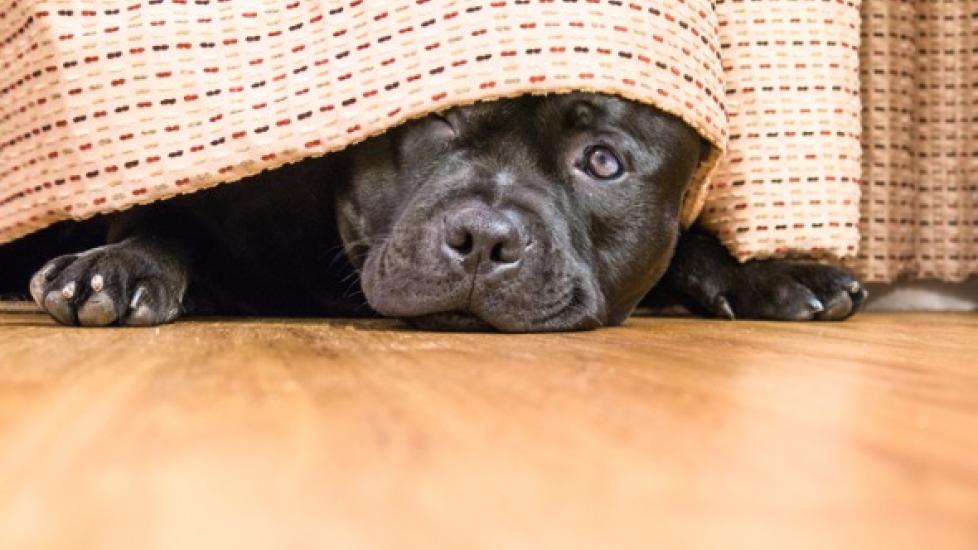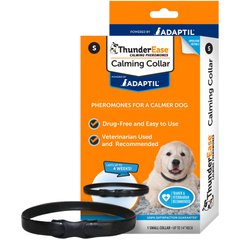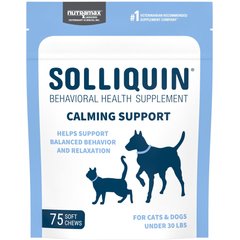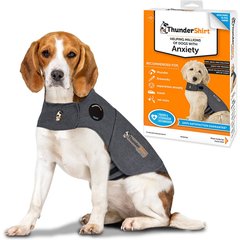Why Do Certain Sounds Scare Dogs?
Updated and reviewed for accuracy on July 24, 2019, by Dr. Katie Grzyb, DVM
Does your dog jump at the sound of thunder or start shaking every time you turn the vacuum on or hide during fireworks? He might be suffering from noise phobia.
A poorly understood condition, noise phobia can actually develop in dogs of all ages, although dogs over a year of age are more likely to suffer from it, according to Kristen Collins, a Certified Applied Animal Behaviorist (CAAB) and the director of the ASPCA's rehab center, which specializes in treating fearful and under-socialized dogs.
“Some dogs simply seem more sensitive and susceptible to developing a fear of noises, and this susceptibility may indicate a genetic predisposition toward the problem,” Collins explains.
Other dogs learn to fear certain sounds. “A dog who isn't initially afraid of a sound can become fearful when an unpleasant event is linked with that noise,” Collins adds.
What Dog Noise Phobia Really Is (and Isn't)
Although they might all sound the same, fear, anxiety and phobia are actually quite different.
Fear in Dogs
“Fear is a physiologic, emotional and behavioral response to animate or inanimate things that pose a threat of harm,” explains Dr. Stephanie Borns-Weil, DVM, DACVB, and clinical instructor at Cummings School of Veterinary Medicine at Tufts University, where she's part of the Animal Behavior Clinic.
Fear is a normal reaction because it enables animals to respond to situations that could be potentially dangerous.
Anxiety in Dogs
Anxiety, on the other hand, is what Dr. Borns-Weil defines as a persistent fear or apprehension of something that is not present or imminent. Essentially, anxiety is a fear of what might happen in the future.
Phobias in Dogs
And finally, there are phobias: extreme, persistent fears of a stimulus, such as a thunderstorm, that are entirely out of proportion to the level of threat it poses.
“Noise phobia is an extreme, persistent fear of auditory stimuli that is out of proportion to the real danger, if any, associated with the noise,” says Dr. Borns-Weil.
“There is no survival advantage conferred on an animal that panics in response to things that are not truly threatening or dangerous,” she explains.
Noise Phobia vs. Thunderstorm Phobia
Although thunderstorms are also a common type of canine phobia, Dr. Borns-Weil says it's important to understand the difference between noise phobia and thunderstorm phobia.
“Storm phobia is multisensory,” Dr. Borns-Weil says. “While it certainly includes very loud noise produced by thunder, other aspects of the storm (flashes of lightning, heavy wind, rain battering the roof, changes in air pressure, etc.) may be either independent fear triggers or become anxiety-inducing predictors of impending thunder.”
Thunderstorm phobia and other noise phobias may co-occur, but they also occur separately, Dr. Borns-Weil adds.
Shop Toys, Training and More
- ThunderEase Powered by ADAPTIL Calming Pheromone Collar for Dogs, Small, up to 14-in neck$19.99Chewy Price
- Nutramax Solliquin Soft Chew Calming Behavioral Health Supplement for Small/Medium Dogs & Cats, 75 count$19.99Chewy Price
- ThunderShirt Classic Anxiety & Calming Vest for Dogs, Heather Grey, Medium$41.64Chewy Price
- Purina Pro Plan Veterinary Diets Calming Care Liver Flavored Powder Calming Supplement for Dogs, 30 count$33.99Chewy Price
Sounds That Trigger Noise Phobia in Dogs
Fireworks, gunshots and vacuum cleaners are common causes of noise phobia, according to Dr. Borns-Weil. “Dogs may also become phobic of fire alarms and even cooking because they associate it with accidental triggering of the alarm,” Dr. Borns-Weil adds.
There are also less common fear triggers, such as crying babies, people sneezing and/or coughing, snow sliding off the roof, and even the clicking of the furnace when it turns on, according to Dr. Borns-Weil.
“I also meet dogs that are fearful of electronic tones,” Dr. Borns-Weil says. “Dogs that have been trained using electronic collars that give a beep before emitting a painful electric shock may become generally fearful of electronic tones, including message alerts on cell phones.”
What Causes Dogs to Develop Phobias of Certain Sounds?
Trying to understand what caused the phobia to develop can be tricky. For example, lack of socialization is often behind the issue.
“Puppies that have insufficient exposure to a variety of normal stimuli during their first four months of life are at higher risk of being overly fearful as adults,” according to Dr. Borns-Weil.
Older dogs can also develop phobias following an exposure to an extremely frightening situation. “Recently, I saw a dog that was extremely frightened of the sound of wind after having been in a home when it was hit by a tornado,” says Dr. Borns-Weil.
And here's something you might not have expected to hear: Your dog's noise phobia could be related to his health. “Any illness, pain or itching may lower a dog’s threshold for anxiety and fearfulness,” according to Dr. Borns-Weil.
Symptoms and Behaviors Associated With Noise Phobias
The symptoms of noise phobia are usually extreme. A dog who's experiencing a phobia episode is panicking, so he'll pace, pant, tremble and hypersalivate.
“Frightened dogs may cower, ears flat against their skulls, eyes wide, muscles tensed and tails tucked,” explains Collins. “Some dogs become restless and move around anxiously with no apparent purpose, while others become immobile, shutting down and unable to move.”
Some fearful dogs cling to their owners, seeking comfort, while others prefer to hunker down on their own, away from people and preferably somewhere dark and quiet.
“I knew one very friendly, loving dog who feared the sound of thunder and only seemed comforted by lying down on a dog bed, alone in a bathtub, until the sound stopped,” Collins says.
It's also not uncommon for dogs with noise phobia to engage in destructive behavior like chewing, digging, scratching and tearing up objects in the home.
“At worst, noise phobias can trigger frantic attempts to escape,” says Collins. “Panicked dogs may scratch and dig frantically at doors or even jump out of windows.”
How to Help a Dog With Noise Phobia
For discrete sounds such as the vacuum cleaner, Dr. Borns-Weil says systematic desensitization and counterconditioning can be a very effective treatment.
Desensitization and Counterconditioning
“It involves the presentation of the frightening sound at a gradually increasing intensity, always making sure to stay below the threshold of intensity that would cause a fear response,” Dr. Borns-Weil explains. “The presentation of the sound is paired with a high-value reward such as food, play or petting.”
Play the recording of the sound at a low volume and give your dog treats. Increase the volume over several training sessions, always keeping an eye on your dog’s body language to make sure he’s not upset by the noise.
However, desensitization and counterconditioning don't work well for certain noise phobias, such as thunderstorm phobia, since storms are multisensory.
“A dog may be desensitized to the sound of thunder with the help of a recording but still will be nervous about the sound of wind, the flashes of light, the rain, the pressure change, the static electricity in the air,” Dr. Borns-Weil says.
Creating a Sense of Safety
For thunderstorm phobia, she says a dog can be taught to go to a “safe place” in the home. Or you can try using sights and sounds—white noise, relaxing music, light blocking shades—to shut out the storm as much as possible. Dog anxiety vests can also be helpful.
Medications and Supplements
There are also natural calming agents which can help some pets, says Dr. Grzyb. VetriScience Composure dog chews, Rescue Remedy and Adaptil collars are options that have worked for some dogs.
Finally, if all else fails, the use of medications, such as sedatives, can be helpful in severely affected pets. For example, Sileo, a medication that is absorbed through the gums, has been approved by the Food and Drug Administration for use in dogs who are fearful of loud noises.
What Not to Do When Your Dog Is Scared
Anything else you can do? It depends on your dog. If you have a dog who approaches you for company and comfort when scared, don't ignore him, and never punish him.
Don’t Ignore Your Dog
“In fact, ignoring and avoiding him may make him feel confused and more fearful,” Dr. Borns-Weil says. So let your boy sit on your lap if that makes him feel better, but keep in mind that providing comfort will not address the underlying problem.
You'll still have to work on helping your dog overcome his fear.
Never Punish a Scared Dog
Whatever you do, never punish or reprimand your dog for being scared.
“Punishing a dog for destructiveness, barking or soiling that is done out of panic will only increase anxiety and make the problem worse,” Dr. Borns-Weil says.
There are many other options if desensitization and counterconditioning are not helping a pet, says Dr. Katie Grzyb, DVM. She recommends using cotton balls or rolled gauze sponges to place in the ear canals, which can lessen the noise during storms and fireworks displays. Just make certain to remove them after the inciting event.
| Nugget: A Case Study of Desensitization and Counterconditioning |
|---|
|
A dog named Nugget became extremely anxious when she heard any large vehicle pass by on the street outside her house. “She and her mom had recently relocated to a busier part of town, so the sounds were new to her,” says Collins. “To help with this, I asked her to buy a CD with traffic noises.”
|
By: Diana Bocco
Featured Image: iStock.com/CBCK-Christine




